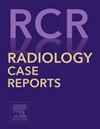An incidental finding of an ectopic intrauterine device (IUD) in the urinary bladder wall in a female presented with missed abortion
Q4 Medicine
引用次数: 0
Abstract
Uterine perforation and migration of intrauterine devices (IUDs) are rare complications that can present significant clinical challenges. We report the case of a 28-year-old woman who came in with a missed abortion at 11 weeks of gestation and was unexpectedly found to have an IUD embedded in the wall of her urinary bladder. She had a history of 5 pregnancies and a copper IUD was inserted a year ago. Although she presented with mild vaginal bleeding, there were no typical urinary symptoms to suggest a problem. However, imaging revealed the copper IUD had migrated outside the uterus and lodged in the bladder. After managing her pregnancy complications with evacuation and curettage, plans were made for surgical removal of the IUD. This case highlights how important it is to consider IUD migration, even when urinary symptoms are not present, in patients with unexplained pelvic issues. Early detection through imaging and prompt removal of the device are essential to prevent further complications. It also emphasizes the value of regular follow-up and patient education to ensure timely identification of potential issues before they escalate.
意外发现异位宫内节育器(宫内节育器)在膀胱壁的女性提出了漏产
子宫穿孔和宫内节育器(iud)的迁移是罕见的并发症,可以提出重大的临床挑战。我们报告的情况下,28岁的妇女谁来了一个错过流产在妊娠11周,意外地发现有一个宫内节育器嵌入在她的膀胱壁。她有5次怀孕史,一年前植入了铜宫内节育器。虽然她表现出轻微的阴道出血,但没有典型的泌尿系统症状表明有问题。然而,成像显示铜宫内节育器已经迁移到子宫外并滞留在膀胱内。在对她的妊娠并发症进行了清除和刮除后,我们制定了手术取出宫内节育器的计划。本病例强调了考虑宫内节育器迁移的重要性,即使在没有泌尿系统症状的情况下,对于无法解释的盆腔问题的患者也是如此。通过成像进行早期检测并及时移除设备对于防止进一步的并发症至关重要。它还强调了定期随访和患者教育的价值,以确保在潜在问题升级之前及时发现问题。
本文章由计算机程序翻译,如有差异,请以英文原文为准。
求助全文
约1分钟内获得全文
求助全文
来源期刊

Radiology Case Reports
Medicine-Radiology, Nuclear Medicine and Imaging
CiteScore
1.10
自引率
0.00%
发文量
1074
审稿时长
30 days
期刊介绍:
The content of this journal is exclusively case reports that feature diagnostic imaging. Categories in which case reports can be placed include the musculoskeletal system, spine, central nervous system, head and neck, cardiovascular, chest, gastrointestinal, genitourinary, multisystem, pediatric, emergency, women''s imaging, oncologic, normal variants, medical devices, foreign bodies, interventional radiology, nuclear medicine, molecular imaging, ultrasonography, imaging artifacts, forensic, anthropological, and medical-legal. Articles must be well-documented and include a review of the appropriate literature.
 求助内容:
求助内容: 应助结果提醒方式:
应助结果提醒方式:


